
Two decades ago, the concept of 3D-printed concrete houses seemed like science fiction. Today, massive 3D printers construct homes layer by layer with remarkable precision. The evolution of construction technology, including innovations like Building Information Modeling (BIM), reads like a futuristic tale but is reshaping our world. Technological innovations are driving significant changes in the commercial construction market.
The construction industry is at a pivotal juncture where the demand for efficient project management is more critical than ever. Complexities and multiple tracking systems often lead to delays, missed deadlines, and cost overruns. Construction project managers need tools and solutions that streamline workflows and bolster productivity in an era marked by stringent deadlines and budgetary constraints.
Leveraging advanced technologies such as predictive intelligence and AI-powered analytics, modern project management tools offer advanced warnings of potential project issues or pending failures. These innovations, including advanced Construction Management Software, offer critical insights, ensuring teams remain cohesive and projects progress seamlessly from conception to completion.
The criticality of leveraging the right tools for digital transformation in construction to navigate the complexities inherent in the construction landscape cannot be overstated. Effective project management solutions are no longer optional but essential for ensuring the timely and cost-efficient completion of construction projects in today’s demanding environment.
This guide delves into the nuances of project management in construction, offering insights tailored for business and technology leaders. We'll explore the importance, functions, best practices, emerging trends, challenges, and strategies. Additionally, we will learn about the transformative impact of advanced technologies like AI and predictive intelligence solutions on enhancing construction outcomes through early warning signs.
Explore how modern project management in construction is powered by predictive intelligence.
Get a quick walkthrough
What is Project Management in Construction? 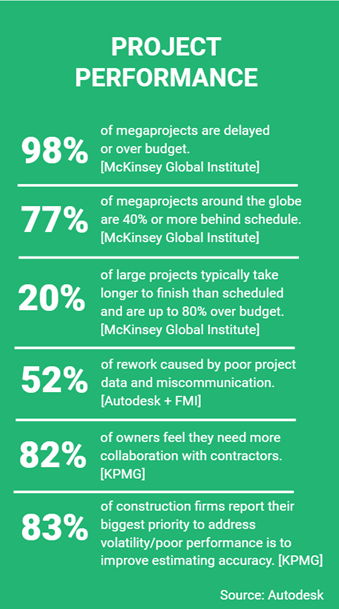
The project management landscape is rapidly evolving, yet many organizations still rely on traditional tools that focus on monitoring progress rather than predicting success. According to a Harvard Business Review report, only 35% of projects meet their original goals, largely due to poor risk visibility, communication silos, and inefficient resource allocation.
AI-driven project management offers a distinct advantage by transforming key processes:
- Real-time project monitoring ensures immediate visibility into risks and performance trends.
- Predictive intelligence detects early warning signs, helping teams take corrective actions before disruptions occur.
- AI-driven automation reduces manual effort, allowing teams to focus on execution rather than repetitive tasks.
- Advanced analytics optimize resource allocation, ensuring project teams work efficiently and strategically.
AI-powered solutions are redefining project selection, risk mitigation, and execution efficiency. Organizations integrating AI today are positioning themselves ahead of the curve, ensuring long-term success in a competitive landscape.
The shift is no longer optional—AI in project management is becoming the industry standard.
Importance of Predictive Project Management in Construction
Effective project management in construction ensures timely, budget-conscious, and legally compliant project completion. Construction management uses specialized techniques and advanced predictive solutions to oversee planning, design, and execution, optimizing industry practices and decision-making.
Key Benefits:
- Financial Efficiency - Eliminate cost overruns and delays through meticulous planning and resource allocation. This financial prudence saves money and boosts investor confidence and stakeholder satisfaction.
- Predictive Awareness - Utilize advanced warning systems to foresee potential issues, allowing proactive adjustments and minimizing risks. Predictive analytics can identify patterns and trends, providing early warnings that enable project managers to address issues before they escalate.
- Data-Driven Decisions - Gain real-time project insights to optimize outcomes. Data-driven decision-making fosters a culture of accountability and continuous improvement, as it is based on measurable performance indicators rather than intuition or guesswork.
- Enhanced Collaboration - Foster seamless communication and accountability across all stakeholders. Collaborative solutions and platforms ensure that everyone is on the same page, reducing the chances of miscommunication and enhancing teamwork.
- Uncompromising Quality - Deliver projects that meet the highest safety and quality standards, maximizing return on investment. Quality management systems ensure that every phase of the project adheres to predefined standards, resulting in superior outcomes.
- Risk Mitigation - Identify and address potential issues before they escalate, ensuring project stability. Risk management strategies, supported by robust software, allow for the systematic identification, analysis, and mitigation of risks.
Functions of Project Management in Construction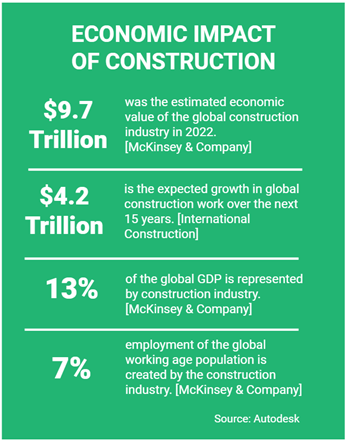
Leveraging effective predictive intelligence and analytics project management in construction ensures projects are delivered on time, within budget, and exceeding quality expectations. Key functions include:
- Project Management Planning - The foundation of success. Detailed planning ensures a smooth progression from start to finish, with clear milestones and deliverables.
- Time Management - Efficient scheduling minimizes project duration and maximizes profitability. Advanced scheduling solutions help manage timelines effectively, ensuring that projects stay on track.
- Contract Administration - Expert contract management ensures compliance with legal requirements for all parties involved, safeguarding the interests of all stakeholders.
- Safety Management - Comprehensive procedures, training, and adherence to regulations guarantee a secure work environment, minimizing accidents and enhancing overall safety.
- Quality Management - Rigorous quality control ensures customer satisfaction by meeting predefined standards, resulting in high-quality deliverables.
- Cost Management - Detailed budgets, meticulous expense tracking, and change management keep projects within budget and profitable.
Strategic Steps to Optimize Outcomes
Transforming your construction business requires a strategic plan. Begin with a robust predictive foundation, followed by research, prioritization, and a detailed plan. Integrate modern ERP systems and AI solutions for predictive analytics and enhanced project outcomes.
Step 1 - Foundation:![]()
- Start with a modern ERP system that leverages digital transformation to streamline your construction project management operations. A robust ERP with advanced analytics serves as the backbone, foreseeing risks and delivering early warnings.
- Evaluate Current ERP Software - Ensure your system provides predictive modeling for compliance risks and offers AI integration options to consolidate predictive insights.
- Incorporate AI Solutions - AI-powered SaaS platforms provide advanced predictive updates and intelligent options that can proactively adapt to project needs.
- Upgrade for Predictive Power - Consider upgrading to an AI-driven ERP system to enhance predictive awareness in operations and outcomes.
Step 2 - Research: ![]()
- Conduct predictive analysis leveraging AI and Lean Construction principles to identify risk areas and opportunities for improvement.
- Explore ERP and SaaS Capabilities - Identify modern systems and SaaS solutions that align with your requirements.
- Set Priorities - Determine the importance of user experience, mobile functionality, and role-based features.
- Engage with ERP and SaaS Partners - Learn about additional modules and features that can enhance safety and compliance.
Step 3 - Prioritize: ![]()
- Leverage predictive modeling to review and rank functional gaps based on forecasted costs, risks, and potential benefits.
- Optimize Existing Processes - Enhance current processes and leverage innovative technologies.
- Implement New Processes - Start with activities that can be quickly implemented using existing technology investments.
Step 4 - Develop a Plan:
- Create a comprehensive predictive plan outlining goals, AI-driven predictive technologies,
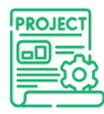
timelines, and risk-mitigated workflows. - Set Goals and Desired Outcomes - Clearly document expected results and benchmark the current state.
- Define Technologies - Specify the technologies to be used and their dependencies.
- Establish a Timeline - Realistically plan the transition period to minimize business disruption.
- Map Out Workflows - Ensure all workflows are documented, highlighting information flow across teams.
- Prepare Contingency Plans - Develop plans for potential technical issues or conflicts.
Take a behind-the-scenes look at how predictive intelligence redefines construction project execution. Watch the use-case video
Best Practices & Strategies for Project Management in Construction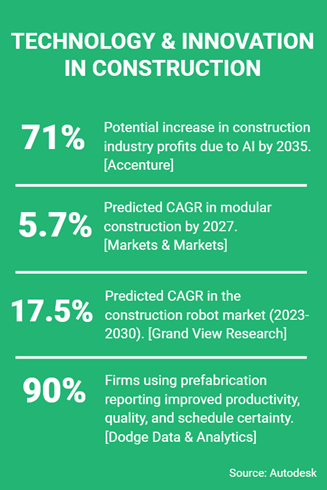
Adopting best practices such as Lean Construction and utilizing advanced technologies can significantly enhance project outcomes.
- Effective Communication - Clear and consistent communication among stakeholders is essential. Use various solutions to ensure everyone is informed and engaged.
- Comprehensive Risk Management - Proactively identify potential risks and develop mitigation strategies.
- Adopting Advanced Technologies - Leverage AI, predictive intelligence solutions, and Building Information Modeling (BIM) for valuable insights and automation capabilities.
- Quality Assurance and Control - Maintain high-quality standards throughout the project lifecycle.
- Efficient Resource Management - Optimal allocation and utilization of resources are critical to project success.
Emerging Trends in Project Management in Construction
Smart technologies and sustainable building practices are transforming the construction industry. Key trends include:
- Sustainability and Green Building - Incorporating eco-friendly materials and methods enhances project value and reduces environmental impact.
- Integrated Project Delivery (IPD) - A collaborative approach that integrates people, systems, and practices to optimize project outcomes.
- Modular Construction - Building sections of a project off-site and assembling them on-site to reduce construction time and costs.
- Smart Construction Technologies - Leveraging predictive intelligence and smart systems to enhance project monitoring and execution.
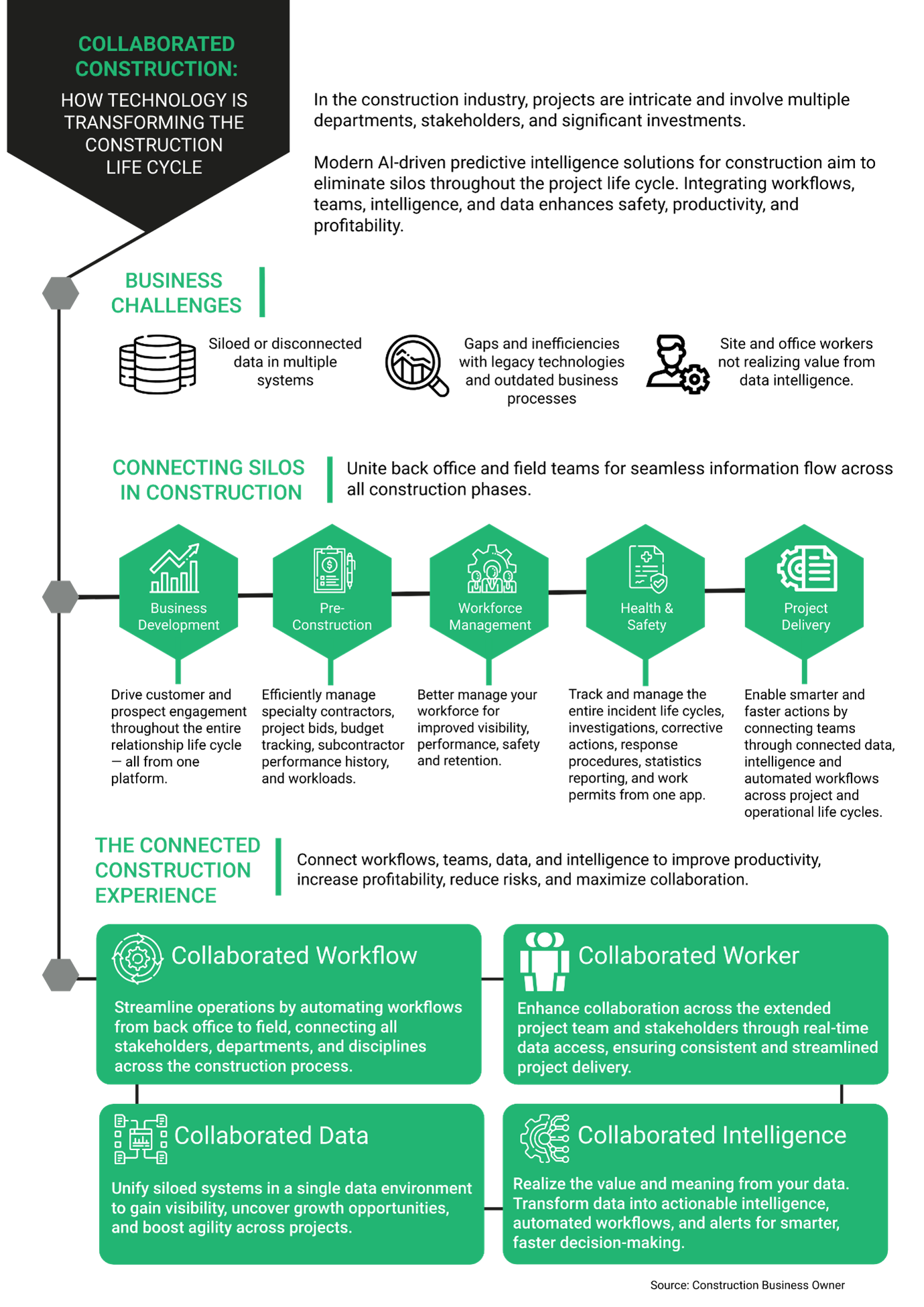
Overcoming Challenges of Project Management in Construction
Managing a construction project is challenging due to its scale, multiple stakeholders, and inherent risks. Effective management requires meticulous planning and precise execution to prevent delays and disputes. Here are the key challenges and solutions:
- Effective Communication and Document Management - Open communication and a centralized document archive are essential. Miscommunication can halt projects, cause cost overruns, or lead to disputes. Use software that centralizes information and communication, ensuring all stakeholders can access the same data.
- Accurate Estimation - Estimating costs, resources, and timelines accurately is crucial. Small errors can lead to significant financial losses. To generate precise estimates, use forecasting tools that consider factors like pricing swings, currency fluctuations, and material shortages.
- Breaking Down Data Silos - Data silos cause miscommunication, delays, and inefficiencies. Adopt a management system that centralizes and integrates essential data, fostering seamless collaboration and informed decision-making.
- Real-Time Data for Risk Assessment and Change Management - Outdated data hinders risk assessment and change management. Construction projects need real-time data to track developments and address challenges. Implement predictive intelligence for advanced warnings and proactive risk management. Use real-time dashboards and reports to visualize workflows and adapt quickly to new challenges, enhancing project outcomes significantly.
Find out how leading teams are using predictive project management in construction to prevent delays before they happen. Download the white paper now!
Catalyzing Transformation in Project Management in Construction
AI and predictive intelligence solutions are revolutionizing project management in construction, unlocking automation, precision, and operational excellence. These technologies empower project managers to make data-driven decisions, anticipate potential pitfalls, and optimize project performance.
Key Benefits:
- Predictive Analytics - Elevate project planning and scheduling mastery, ensuring meticulous execution.
- AI-Driven Insights - Fortify risk management prowess, enabling early identification of potential risks.
- Automated Tasks - Liberate strategic focus by minimizing manual effort on routine tasks.
- Real-Time Monitoring - Amplify control and visibility with continuous updates on project status.
- Optimized Efficiency - Achieve streamlined processes and maximized output through automation and data-driven insights.
Steps for Efficient Project Management in Construction
Creating a construction plan can be complex, but it doesn’t have to be overwhelming. Leveraging leading solutions in the construction industry provides actionable insights for seamless planning from initiation to completion. Using modern predictive AI solution capabilities benefits both experienced professionals and novices by providing solutions that simplify and enhance every step of the process.
Steps:
- Establish Project Scope - Define goals, deliverables, timelines, and budget constraints.
- Develop a Work Breakdown Structure (WBS) - Break down the project scope into manageable segments.
- Formulate a Project Schedule - Create a detailed schedule using tools like Gantt charts.
- Monitor Progress - Update task achievements and resource utilization with advanced analytical solutions.
- Foster Communication and Collaboration - Engage stakeholders with integrated communication features.
By following these steps, you can leverage predictive project management solutions to streamline project management in construction, boost efficiency, and enhance collaboration.
Conclusion
Project management in construction is no longer about status updates and milestone checklists. It’s about controlling complexity with foresight and acting on early signals before delays, cost overruns, or quality issues surface. Construction leaders today need systems that don't just track—they interpret, alert, and drive proactive decisions in real-time.
This shift is especially critical in construction, where margins are tight, variables are many, and project momentum can turn on a single unnoticed risk. Predictive project management brings the precision and control needed to steer outcomes—not just observe them.
TrueProject, a KPI-driven, predictive SaaS solution for project management, is the only solution that pairs real-time system data with stakeholder sentiment to give you a holistic, 360° view of project health. While others show you where things stand, TrueProject tells you why and what’s next. In construction, where delays compound and misalignment can spiral quickly, the ability to course-correct in advance is a necessity. TrueProject empowers leaders to detect performance breakdowns early, understand the root cause—whether it's poor communication, misprioritized tasks, or stakeholder friction—and act decisively. It's built to support high-stakes decision-making by turning complex project signals into clarity and confidence.
Let us show you what proactive project management in construction really looks like—with your own data. Request a personalized demo.
More information about TrueProject on trueprojectinsight.com

About the Author:
Nisha Antony is an accomplished senior marketing communications specialist at TrueProject and a leader in predictive intelligence. With over 16 years of experience, she has worked as a Senior Analyst at Xchanging, a UK consulting firm, and as an Internal Communications Manager on a major cloud project at TE Connectivity. She is an insightful storyteller who creates engaging content on AI, machine learning, analytics, governance, project management, cloud platforms, workforce optimization, and leadership.





